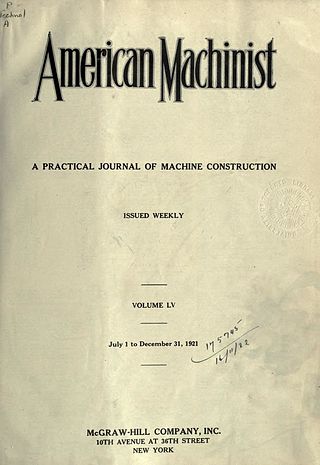
A machine is a physical system that uses power to apply forces and control movement to perform an action. The term is commonly applied to artificial devices, such as those employing engines or motors, but also to natural biological macromolecules, such as molecular machines. Machines can be driven by animals and people, by natural forces such as wind and water, and by chemical, thermal, or electrical power, and include a system of mechanisms that shape the actuator input to achieve a specific application of output forces and movement. They can also include computers and sensors that monitor performance and plan movement, often called mechanical systems.

A machinist is a tradesperson or trained professional who operates machine tools, and has the ability to set up tools such as milling machines, grinders, lathes, and drilling machines.
A millwright is a craftsperson or skilled tradesperson who installs, dismantles, maintains, repairs, reassembles, and moves machinery in factories, power plants, and construction sites.
Harry Franklin Vickers was an American inventor and industrialist. He grew up in Montana and southern California. He was called the "Father of Industrial Hydraulics" by the American Society of Mechanical Engineers, who gave him the Society's highest award, the ASME Medal, in 1956.
British Standard Whitworth (BSW) is an imperial-unit-based screw thread standard, devised and specified by Joseph Whitworth in 1841 and later adopted as a British Standard. It was the world's first national screw thread standard, and is the basis for many other standards, such as BSF, BSP, BSCon, and BSCopper.

Trapezoidal thread forms are screw thread profiles with trapezoidal outlines. They are the most common forms used for leadscrews. They offer high strength and ease of manufacture. They are typically found where large loads are required, as in a vise or the leadscrew of a lathe. Standardized variations include multiple-start threads, left-hand threads, and self-centering threads.

A machine shop or engineering workshop is a room, building, or company where machining, a form of subtractive manufacturing, is done. In a machine shop, machinists use machine tools and cutting tools to make parts, usually of metal or plastic. A machine shop can be a small business or a portion of a factory, whether a toolroom or a production area for manufacturing. The building construction and the layout of the place and equipment vary, and are specific to the shop; for instance, the flooring in one shop may be concrete, or even compacted dirt, and another shop may have asphalt floors. A shop may be air-conditioned or not; but in other shops it may be necessary to maintain a controlled climate. Each shop has its own tools and machinery which differ from other shops in quantity, capability and focus of expertise.

Leon Pratt Alford was an American mechanical engineer, organizational theorist, and administrator for the American Society of Mechanical Engineers. known for his seminal work in the field of industrial management.

Fred Herbert Colvin (1867–1965) was an American machinist, technical journalist, author, and editor. He wrote, co-wrote, edited, or co-edited many periodical articles, handbooks, and textbooks related to engineering, machining, and manufacturing. His autobiography, Sixty Years with Men and Machines, provides a thorough and colloquial look into the decades of 1880 to 1950, giving insight into the culture of the Machine Age.
American Machinists' Handbook was a McGraw-Hill reference book similar to Industrial Press's Machinery's Handbook.
Black oxide or blackening is a conversion coating for ferrous materials, stainless steel, copper and copper based alloys, zinc, powdered metals, and silver solder. It is used to add mild corrosion resistance, for appearance, and to minimize light reflection. To achieve maximal corrosion resistance the black oxide must be impregnated with oil or wax. One of its advantages over other coatings is its minimal buildup.
Indexing in reference to motion is moving into a new position or location quickly and easily but also precisely. When indexing a machine part, its new location is known to within a few hundredths of a millimeter, or often even to within a few thousandths of a millimeter, despite the fact that no elaborate measuring or layout was needed to establish that location. In reference to multi-edge cutting inserts, indexing is the process of exposing a new cutting edge for use. Indexing is a necessary kind of motion in many areas of mechanical engineering and machining. An object that indexes, or can be indexed, is said to be indexable.
United States Standard thread, also known as Sellers Standard thread, Franklin Institute thread and American Standard thread, is a standard for inch based threaded fasteners and washers.

Oliver Byrne was a civil engineer and prolific author of works on subjects including mathematics, geometry, and engineering. He is best known for his 'coloured' book of Euclid's Elements. He was also a large contributor to Spon's Dictionary of Engineering.
Franklin Day Jones (1879–1967) was an author in mechanical engineering and toolmaking. He wrote the first edition of Machinery's Handbook, with engineer Erik Oberg.
Charles Oscar Eugene Perrigo was an American mechanical engineer, inventor, and early technical and management author, known for his work on machine shop construction and management, and for his work on lathe design, construction and operation.

Engineering Magazine was an American illustrated monthly magazine devoted to industrial progress, first published in 1891. The periodical was published under this title until October 1916. Sequentially from Nov. 1916 to 1927 it was published as Industrial Management.

The American Machinist is an American trade magazine of the international machinery industries and most especially their machining aspects. Published since 1877, it was a McGraw-Hill title for over a century before becoming a Penton title in 1988. In 2013 it transitioned from combined print/online publication to online-only.

Fred J. Miller was an American mechanical and industrial engineer, known for his seminal work in designing high-precision scientific instruments, and as president of the American Society of Mechanical Engineers in 1920–21.













